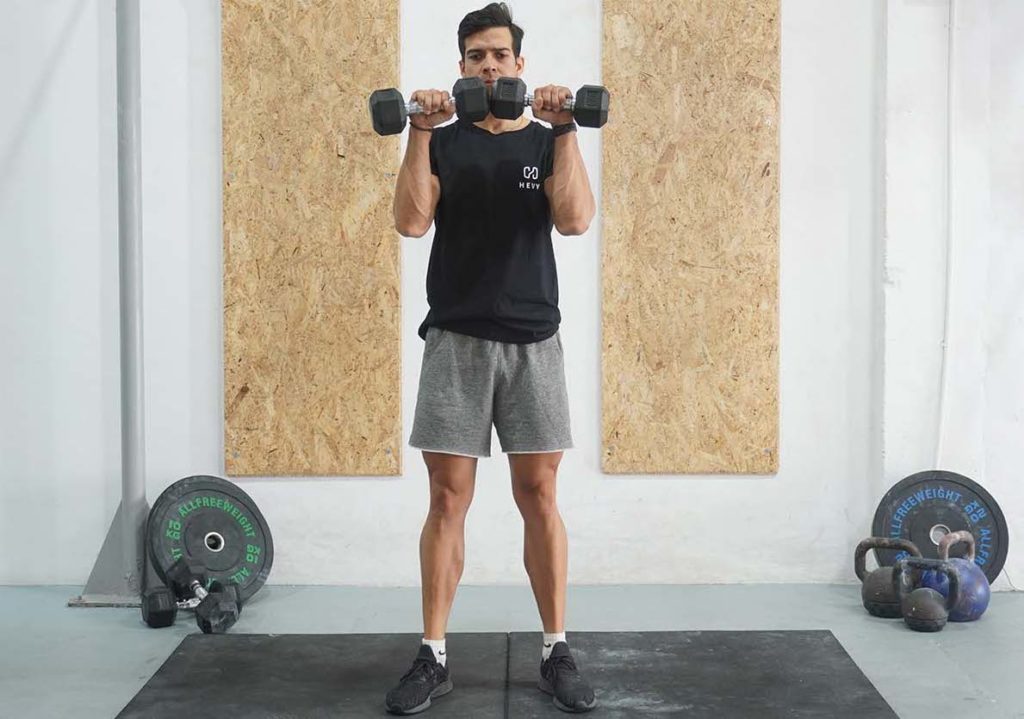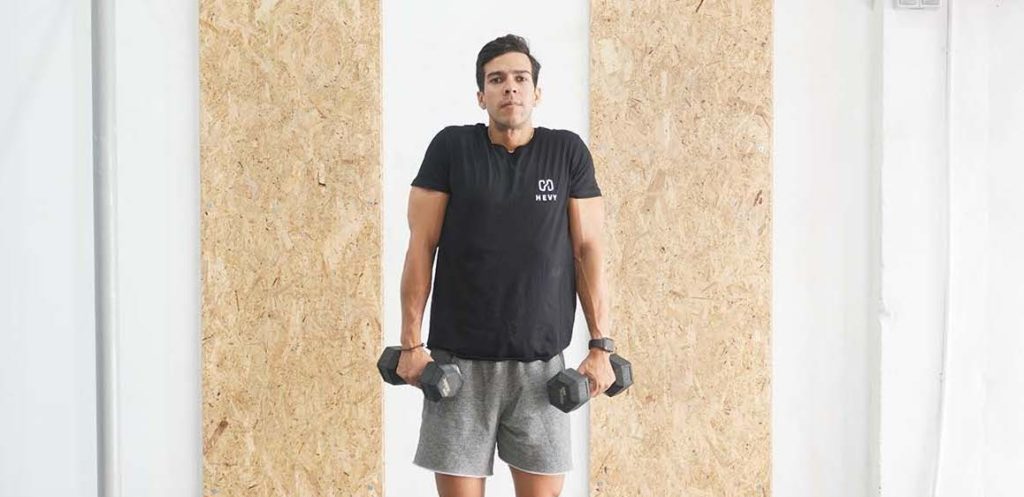Benefits of the Behind the Back Bicep Wrist Curl with a Barbell
Many people avoid direct forearm training. But working your forearms brings two significant benefits. First, you develop a set of muscular forearms that look great. Second, forearm training strengthens your grip (1). As a result, you can hold weights more comfortably and prevent grip strength from ever being a limiting factor in your training.
Having a solid grip is also beneficial for your daily life. For example, holding weights is easier, and you can effortlessly carry objects, such as bags full of groceries.
While there are tons of ways to approach forearm training, behind the back wrist curls are one of the simplest and most effective movements you can do. The exercise offers a good range of motion; it has a significant overloading potential and is easy to learn.
How to do a Behind the Back Bicep Wrist Curl

- Place an empty barbell on a rack positioned at mid-thigh level.
- Face away from the barbell and grab it evenly with your palms facing back.
- Brace your abs, take a breath, and unrack the barbell.
- Bring your shoulders back, spread your feet hip-width apart, keep your abs tense, and squeeze your glutes. Your arms should be to your sides.
- Take a breath and curl the barbell by flexing your wrists as much as you can.
- Hold the top position for a moment and lower the barbell by extending your wrists. As the barbell moves down, allow it to roll to your fingertips. Exhale.
- Take another breath and curl the barbell again.
- Once finished, carefully place the barbell on the rack.
What muscles are activated with the behind the back bicep wrist curl?
The primary muscles involved with the behind the back barbell curls are the forearms. The exercise emphasizes our wrist flexors (flexor carpi radialis and flexor carpi ulnaris), which produce the force needed to curl the barbell (2, 3). These same muscles also engage in lowering the barbell back to the starting position.
Behind the back wrist curls involve other forearm muscles, such as the brachioradialis, but to a much smaller degree. Most other muscles flex isometrically to help us hold onto the barbell as we go through the exercise.
Unlike many forearm movements, behind the back wrist curls are also beneficial for core engagement. Our abs, transverse abdominis, obliques, erector spinae, and glutes engage to keep us upright and stable during the movement.
Tips to Master the Behind the Back Bicep Wrist Curl with a Barbell
The most important tip to remember for behind the back curls is to use the appropriate load. Doing so will allow you to do each repetition with a full range of motion and good technique. In contrast, using more weight often leads to poor technique and increases the risk of dropping the barbell behind you. The goal is to do at least ten smooth repetitions with a good range of motion.
Like many beginners, you might struggle to do the exercise with a traditional 20-kilogram barbell. If so, use a lighter straight bar to build a foundation.
Another critical element of a good behind the back wrist curl is maintaining a stable and upright position. So, engage your midsection and squeeze your glutes before each set.
The last tip to keep in mind for the movement is to do each repetition slowly and with reasonable control. Feel your forearms stretch as you lower the barbell, then follow up with a forceful squeeze at the top position.
Variations and Modifications of the Behind the Back Bicep Wrist Curl with a Barbell
1. Single-Arm Behind The Back Wrist Curl
The single-arm behind the back wrist curl is an excellent variation that lets you focus on one forearm at a time. The goal is to hold onto a dumbbell or kettlebell and follow the instructions we shared earlier.
2. Behind The Back Cable Wrist Curl
The cable version of the wrist curl is a perfectly viable option. You can overload your forearms with a lot of weight thanks to the constant tension you receive from the cable. Plus, depending on the attachment you use, you can train both arms simultaneously or one at a time.
3. Behind The Back Pause Wrist Curl
Adding a pause is a fantastic way to make any exercise more challenging. Doing so is particularly beneficial for wrist curl exercises because many people struggle to form a good mind-muscle connection with their forearms. By adding a pause, you learn how to activate the muscles in your forearms.
Mistakes to Avoid
A common mistake related to behind the back wrist curls is using a partial range of motion. Trainees often use more weight than they should, limiting their ability to do the exercise effectively. Avoid the error by starting with a lightweight and moving the bar through a full range of motion. Feel your forearms stretch as you lower the barbell and follow that with a forceful contraction.
A similar mistake to the first one relates to using momentum to lift the bar and not controlling it on the way down. Doing so is bad because you cannot put as much tension on your muscles and instead force your connective tissues to support a more significant percentage of the load. Like the first mistake, avoid the error by being mindful of your technique, using a full range of motion, and doing repetitions smoothly.
The third significant mistake related to behind the back wrist curls is doing the same thing repeatedly. Like any other muscle in the body, our forearms benefit from increasingly greater tension, which comes from progressive overload: doing more work as time passes. So, look for ways to keep challenging yourself. Use more weight, do more reps and sets, add a brief pause at the top, and train your forearms more frequently throughout the week.
Similar Exercises to the Behind the Back Bicep Wrist Curl with a Barbell
Zottman Curl (Dumbbell)

Zottman dumbbell curls are a bicep and forearm exercise with numerous benefits. The goal with the movement is to curl the dumbbells with palms facing up, rotate your wrist 180 degrees at the top, and finish the repetition with a reverse-grip curl. Doing so is a practical way to train your biceps and forearms evenly.
Shrug (Dumbbell)

While primarily a trapezius exercise, the shrug is excellent for forearm growth. The goal with the movement is to grab a pair of dumbbells, stand tall, and begin to elevate and lower your shoulders. In doing so, you strengthen and develop your upper back muscles. But since shrugs force you to hold a pair of heavy dumbbells, your forearms and hands also work hard.
Seated Wrist Curl (Dumbbell)
The seated wrist curl is a great isolation movement for your forearms. You have to grab a dumbbell, sit on a gym bench, place your forearm on your thigh, and have your palm face the ceiling. You then have to flex and extend your wrists, training the same muscles as you would with behind the back wrist curls.

